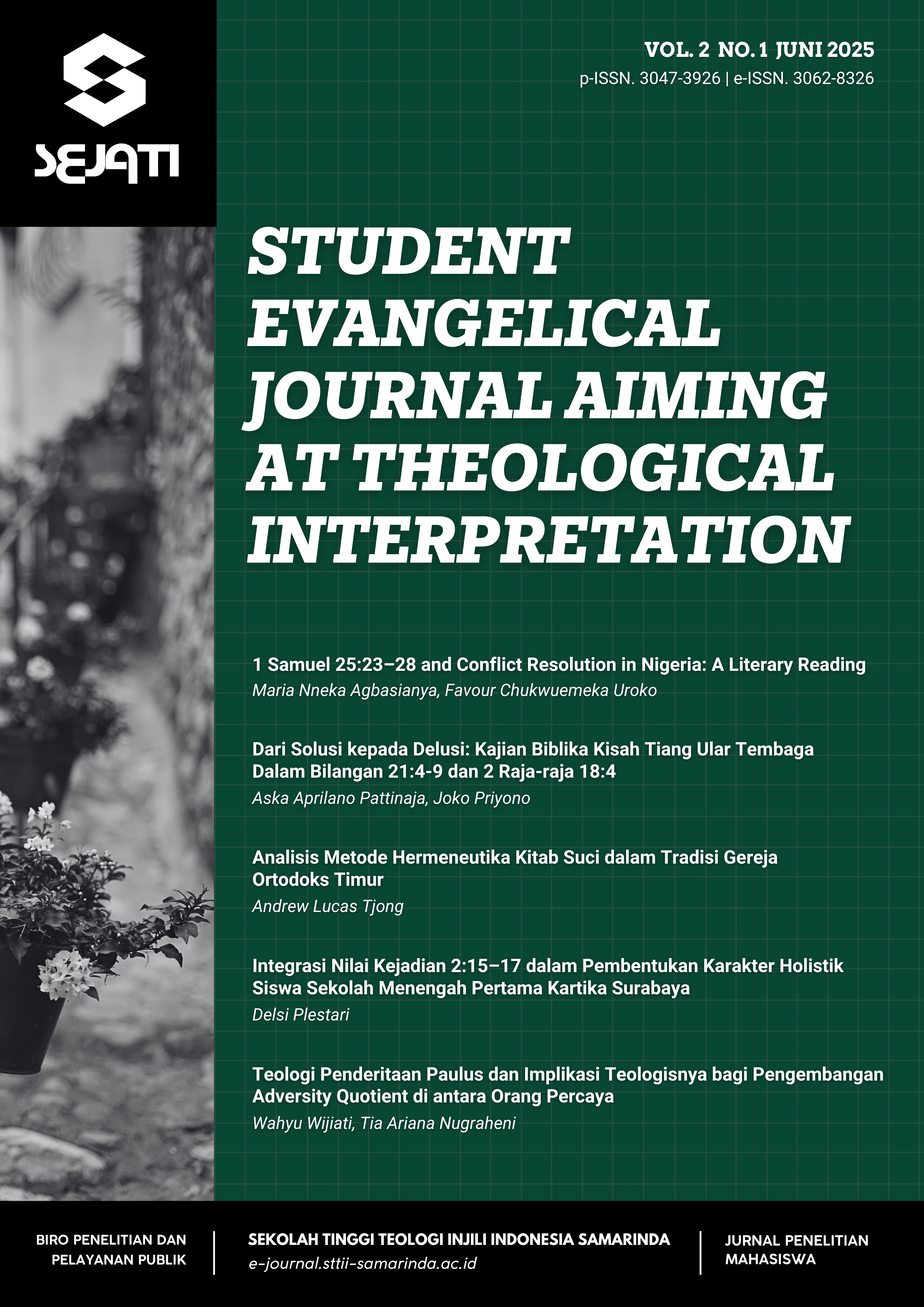Analisis Metode Hermeneutika Kitab Suci dalam Tradisi Gereja Ortodoks Timur
DOI:
https://doi.org/10.69668/sejati.v2i1.95Keywords:
hermeneutics, Eastern Orthodox Church, sacred tradition, church fathers, church’s lifeAbstract
This article aims to elucidate the principles and approaches of hermeneutics within the Eastern Orthodox Church tradition through a library research method that examines the documents and literature of the Eastern Orthodox Church. The hermeneutical method of the Eastern Orthodox Church emphasizes communal interpretation, the unity of Holy Scripture with Holy Tradition, the role of the Holy Spirit in interpretation, the continuity of apostolic succession, and an orientation toward the spiritual transformation of the faithful. The approaches employed include the Christological-Pneumatological, ecclesiological and patristic, literal, allegorical-typological, ethical, moral and spiritual, ascetic, as well as liturgical and iconographic approaches. Collectively, these approaches demonstrate that Eastern Orthodox hermeneutics is inseparable from the life of the Church and aims to lead the faithful toward theosis, the union with God. This article affirms that, in the Eastern Orthodox Church, Holy Scripture is understood holistically as the living Word, interpreted in the light of the Church’s faith, and lived out in the spiritual life of the faithful.
References
Alfeyev, H. (2025). St. Symeon the New Theologian and Orthodox Tradition. Oxford University Press.
Basil the Great. (2016). The Hexaemeron. Aeterna Press.
Behr, J. (2001). The Way to Nicaea (Vol. 1). St Vladimir's Seminary Press.
Behr, J. (2004). The Trinitarian Being of the Church. St. Vladimir’s Theological Quarterly, 48(1), 67–88.
https://frjohnbehr.com/wp-content/uploads/2019/07/Behr-Trinitarian_Being_of_Church.pdf
Behr, J. (2006). The Mystery of Christ: Life in Death. St. Vladimir's Seminary Press.
Beirne, M. (2013). St. Athanasius and the Scriptures, Exemplified in his Letter to Marcellinus. Phronema, 28(2), 89–106.
Bowen, G.A. (2009). Document Analysis as a Qualitative Research Method. Qualitative Research Journal, Vol. 9 No. 2,
pp. 27–40. https://doi.org/10.3316/QRJ0902027
Bradshaw, D. (2004). Aristotle East and West: Metaphysics and the Division of Christendom. Cambridge University
Press.
Brown, R. E. (2015). An Introduction to the New Testament. Yale University Press.
Carson, D. A. (1996). Exegetical Fallacies. Baker Books.
Chryssavgis, J. (2008). In the Heart of the Desert: The Spirituality of the Desert Fathers and Mothers. World Wisdom,
Inc.
Deane, H. (2008). The Third Book of St. Irenaeus Bishop of Lyons Against Heresies. Wipf and Stock Publishers.
Demacopoulos, G. E., & Papanikolaou, A. (Eds.). (2013). Orthodox Constructions of the West. Fordham University
Press.
Dulles, A. (1992). Models of Revelation. Orbis Books.
Elwell, W. A. (Ed.). (2001). Evangelical Dictionary of Theology (Baker Reference Library). Baker Academic.
Florovsky, G. (1972). Bible, Church, Tradition: An Eastern Orthodox View. Lulu.com.
Gregory of Nazianzus. (2018). The Five Theological Orations of Gregory of Nazianzus. Forgotten Books.
Grudem, W. A. (2009). Systematic Theology: An Introduction to Biblical Doctrine. Zondervan Academic.
Jillions, John A. (2022). Bishops and Pentecost: Authority and Charisms in the Orthodox Church. Journal of Pentecostal
Theology 31, no. 2: 171–183. https://doi.org/10.1163/17455251-31020002
John Chrysostom. (2010). Commentary on Saint John the Apostle and Evangelist, Homilies 1–47 (The Fathers of the
Church, Volume 33) (Vol. 33). CUA Press.
John Chrysostom. (2015). The Homilies of Saint John Chrysostom: On the Gospel of Saint Matthew. Aeterna Press.
Kelly, J. N. D. (2000). Early Christian Doctrines. A&C Black.
Louth, A. (1989). Discerning the Mystery: An Essay on the Nature of Theology. Oxford University Press.
Louth, A. (2013). Introducing Eastern Orthodox Theology. Intervarsity Press.
Lossky, V. (1976). The Mystical Theology of the Eastern Church. St Vladimir’s Seminary Press.
McGrath, A. E. (2011). Christian Theology: An Introduction. John Wiley & Sons.
McGuckin, J. A. (Ed.). (2010). The Encyclopedia of Eastern Orthodox Christianity. John Wiley & Sons.
Meredith, A. (2012). Gregory of Nyssa. Routledge.
Meyendorff, J. (1978). Living Tradition: Orthodox Witness in the Contemporary World. St. Vladimir's Seminary Press.
Meyendorff, J. (1979). Byzantine Theology: Historical Trends and Doctrinal Themes. Fordham University Press.
Moschos, D. (2019). Metropolitan Kallistos of Diokleia as historian of the Eastern Orthodox Church. International
Journal for the Study of the Christian Church, 19(4), 240–247. https://doi.org/10.1080/1474225X.2019.1675123
Ouspensky, L., & Lossky, V. (1982). The Meaning of Icons. St. Vladimir’s Seminary Press.
O'Collins, G. (2014). The Second Vatican Council: Message and Meaning. Liturgical Press.
Palmer, G. E. H., Sherrard, P., & Ware, K. (Eds.). (1986). The Philokalia: The Complete Text, Vol. 2. Faber & Faber.
Pelikan, J. (2018). The Christian Tradition: A History of the Development of Doctrine, Volume 1: The Emergence of the
Catholic Tradition (100-600) (Vol. 1). University of Chicago Press.
Schmemann, A. (2003). Introduction to Liturgical Theology. St. Vladimir's Seminary Press.
Schneiders, S. M. (1999). The Revelatory Text: Interpreting the New Testament as Sacred Scripture. The Liturgical
Press.
Sheehan, M. (1959). Apologetics and Catholic Doctrine: A Course of Religious Instruction for Schools and Colleges. Gill
and Son.
Tanner, N. P., & Alberigo, G. (1990). Decrees of the Ecumenical Councils. Sheed & Ward.
Thiselton, A. C. (2009). Hermeneutics: An Introduction. Wm. B. Eerdmans Publishing.
Tjong, A. L., Prasetyo, W., & Zalukhu, E. (2025). A Hermeneutical Study of 2 Corinthians 3: 3 on The Nature of
Christians. Theological Journal Kerugma, 8(1), 19–26. https://doi.org/10.33856/kerugma.v8i1.484
Ware, T. (1993). The Orthodox Church: An Introduction to Eastern Christianity. Penguin UK.
Zacharou, Z. (2010). Remember Thy First Love: The Three Stages of the Spiritual Life in the Theology of Elder
Sophrony. Stavropegic Monastery of St. John the Baptist.



 ENCE TOOLS
ENCE TOOLS









